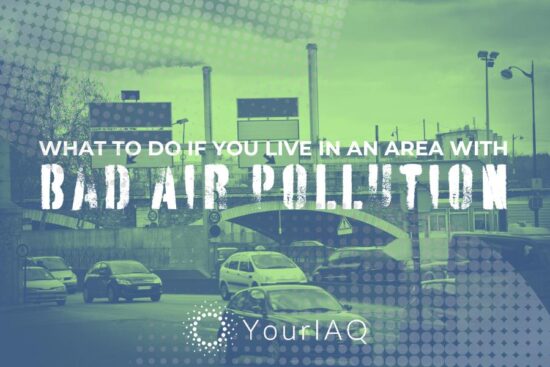
In recent years, you’ve probably heard a lot about indoor air quality, air purifiers, and improving air inside the home, especially after Covid. But what is indoor air quality? How is indoor air quality measured? And most importantly, is this something you should be worried about?
If you’re looking for answers to any of these questions, you’ve come to the right place. In this article, we’ll attempt to clearly define indoor air quality, identify the common factors that affect it, and provide tips for measuring and managing indoor air.
What Is Indoor Air Quality?
Indoor air quality is the relative healthiness of air inside any building, including your home, school or workplace. The quality of indoor air fluctuates depending on the gasses, particulate matter, and microbial elements it contains.
The air we breathe is made up primarily of gasses—approximately 78% nitrogen, 21% oxygen and smaller amounts of other gasses. Beyond these primary components, air also contains water vapor, microorganisms, and other chemicals, some of which can be dangerous to our lungs. Other characteristics that may contribute to indoor air quality include relative humidity, temperature, and atmospheric pressure.
Generally speaking, the fewer harmful pollutants indoor air contains, the higher the air quality.
What Are the Most Common Indoor Air Pollutants?
Common pollutants that degrade air quality fall into two primary groups, biological and chemical. Some of the most unhealthy include the following:
Biological Indoor Air Pollutants
- Bacteria
- Mold
- Airborne viruses
- Animal dander
- Pet saliva
- Dust mites
- Insect droppings
- Pollen
Chemical Indoor Air Pollutants
- Asbestos
- Carbon monoxide
- Ozone
- Particulate Matter
- Pesticides
- Radon
- Smoke
- VOCs (volatile organic compounds)
Read more: Most Common Indoor Air Pollutants According to the EPA
Common Sources of Pollutants in the Home
A number of potential sources may contribute to indoor air pollution. Here are some of the more common culprits:
- Combustion engines
- Cooking fumes
- Dust from furnishings or building materials
- Extensive use of air fresheners, disinfectants, and cleaning agents
- Fires (indoor or outside)
- Gas appliance usage and gas line leaks
- Heating and cooling systems, and dehumidifiers
- High temperatures and humidity
- Insect infestations
- Insulation (especially older materials)
- Paint, varnish, and polishing agents
- Pets
- Pollen
- Poor ventilation
- Presence of mold
- Rotten food or plant matter
- Smoking
- Unclean spaces
Read more: Everyday Household Items You Didn’t Know Were Polluting Your Air
Why Is Indoor Air Quality Important?
Perhaps surprisingly, indoor air quality can be significantly poorer than outdoor air quality, and most Americans spend far more time indoors than outside. Studies by the EPA have found that indoor air can be multiple times unhealthier than outside air in the same location.
Furthermore, indoor air quality can worsen over time. Without proper ventilation, your home’s air can quickly accumulate high levels of VOCs and particulate matter. VOCs are man-made chemicals often found in household products or those created as byproducts of industrial processes. High levels of VOCs can be harmful to health and drastically affect property values.
Read more: The Importance of Indoor Air Quality
How Does Indoor Air Quality Affect Health?
In simple terms, indoor air quality is extremely important to human health, as exposure to poor air can lead to a wide range of illnesses and maladies. Poor indoor air can lead to health issues such as eye irritation, headaches, fatigue, and asthma. It can also reduce performance and exacerbate existing health problems. In the worst of cases, breathing low quality air over prolonged periods can lead to life-threatening diseases such as lung disease and cancer.
Unfortunately, the air we breathe is for the most part invisible and odorless, so air quality often gets overlooked. This contributes to people taking clean air for granted and ignoring what’s in it until a health problem arises.
How Is Indoor Air Quality Measured?
Measuring indoor air quality requires monitoring the relative levels of what’s in the air. Variables in relative humidity, temperature, carbon dioxide, particulate matter, VOCs, air pressure, and other pollutants provide cues as to how air quality changes.
Some indoor air pollution is easy to measure and monitor with your own senses, such as the sight of vapor or the smell of gas. But more sophisticated measurement requires the use of sensors. In the U.S., most households use basic smoke detectors and carbon monoxide alarms with sensors that can track the air for the presence of these pollutants.
Measuring particulate matter, VOCs, radon, ozone, and other harmful contaminants requires the use of different sensors. Until recently, detecting levels of all the most common indoor pollutants required either extremely sophisticated equipment or a large number of different devices for each pollutant. Advances in technology have led to indoor air quality monitors that can measure more contaminants than ever before.
How Do Indoor Air Quality Monitors Work?
Indoor air quality monitors have sensors that continuously sample the air for pollutants. In basic terms, these sensors are designed to pick up subtle changes in air particles that are consistent with the presence of specific contaminants.
These devices can trigger reactions, such as audible alerts, when surrounding air quality reaches unsafe levels.
How Measuring Air Quality Can Improve Your Health
You’re aware of the dangers of indoor air pollution, you understand how it’s measured and what pollutants are most problematic. Now what? Here are a few tips for measuring air quality and then taking the necessary steps to ensure a safe and healthy home.
- Get indoor air quality monitors and regularly check in on air quality. It’s especially important to understand how your air quality fluctuates over time.
- Make sure to place sensors in critical areas to get full home coverage. Focus on common spaces and place them away from direct sunlight, induction units, fans, and heaters. If possible, place them at or slightly below the height of people.
- Find and mitigate the source of any elevated levels of pollutants. Some problems may require expert intervention, i.e. mold or asbestos.
- Ensure proper ventilation, but understand when the problem is coming from outside. Make sure outdoor air intake is not near a source of moisture or something creating a pollutant
- Use air filters in your HVAC system and regularly check and replace
- Keep your home clean and sanitary.
- Use a humidifier to add moisture to the air, if necessary, or a dehumidifier to remove it. Keeping the air between 40% and 60% humidity is a good target, according to the CDC.
- Consider an air purifier, especially if you have a confined space with poor ventilation.
Frequently Asked Questions
How can I test the air quality in my home?
The easiest way to get a comprehensive reading of the air quality in your home is by placing one or more air quality monitoring devices in your living space. Today’s monitors can detect a wide variety of air contaminants. IAQ by Sensables monitors for more than 20 indoor air pollutants, including the primary contaminants the EPA warns about, and provides an easy to read data dashboard with real time information.
What are the main indicators of indoor air quality?
Important components of indoor air quality include relative humidity, temperature, CO and CO2 levels, particulate matter (PM2.5), atmospheric pressure, and the presence of volatile organic compounds (VOCs), dust, smoke, pollen, mold, microorganisms and other gases. Relatively elevated levels of these pollutants can be harmful to human health.
What are some common sources of air pollution in the home?
Sources of air pollution in the home include soot, smoke, dust, dirt, mold spores, pet dander, pollen, VOCs, household chemicals, cosmetics, cooking fumes, insects, gas appliances, HVAC systems, rotten food, building materials, paint, and outside sources.
What is acceptable indoor air quality?
It varies depending on every individual’s sensitivities and preferences. However, healthy indoor air is largely free of excessive dust, dirt, pollen, mold, pet dander, smoke, lead, and other particulates. Other than oxygen and nitrogen, indoor air should contain no more than very small amounts of gasses.
Learn how IAQ can help you take control of your home’s air quality.






